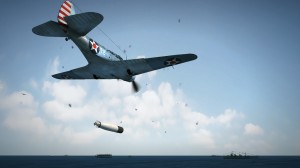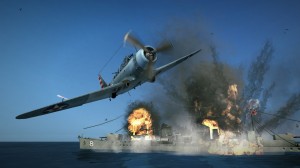Damage Inc: Pacific Squadron Single-Player Review (360)
- Updated: 4th Sep, 2012
 The first thing that came to mind when I heard about Damage Inc: Pacific Squadron WWII was “Can you drop the bomb on Hiroshima?” I am a bad person.
The first thing that came to mind when I heard about Damage Inc: Pacific Squadron WWII was “Can you drop the bomb on Hiroshima?” I am a bad person.
Set in the Pacific during the US’s entry into World War II (it’s right there in the title), this game is about dogfighting. Lots of dogfighting. Sometimes you’ll be shooting jeeps on a beach, sometimes you’ll be blowing up destroyer ships but mostly you’ll be dogfighting.
It’s fun for a while. The arcade mode defies physics well enough that all but the most inept pilots can get by. There’s a handy “War Speed” button to quickly close long distances and a useful slow-motion zoom feature for precision aiming. But five or six missions in and it all starts to feel a little too superficial.
I’m loath to say it’s too easy. It is easy on normal mode but every two or three missions, what promises to be just another short recon flight gets extended and extended to a 40-minute monster.
You’ll finish your objective and lo, there are more planes on the horizon. Take them out and oh no! Destroyers have been spotted just off the coast. Its keeps you on your toes and yes, it’s probably a reasonable representation of what actually happened to pilots but it stops being fun long before the mission is over. At least the checkpoints are well-placed so if you do crash into the sea, you haven’t lost much progress.
The designers have chosen to put the zoom, the throttle and the trigger all on the right side of the controller, so these epic missions invariably leave me with a painful and cramped hand. Published by accessories producer Mad Catz, it’s easy to dismiss the game as an excuse to flog some specialist hardware. You’d probably be right.
You can buy Damage Inc. on its own or with a bundled Xbox 360 joystick from Saitek at just under twice the price. Our bundled joystick has a permanent yaw to the left, even after we reasssembled it several times. If only it came with a team of engineers to perform maintenance after every flight.
I consulted with Nick Silversides, our resident flight expert, for the “simulator” mode:
After plugging in the flight stick and setting the game to simulator (in-cockpit view) I was expecting a flight sim experience. It didn’t start off well as I was congratulated on my take-off while still picking up speed down the runway. The flight model was so basic it didn’t really matter what speed or angle of attack I used, I was going to take off.
Shortly after leaving the ground I started a turn to the right. I breezed passed a 45 degree angle of bank without a hint of nose or airspeed drop. Even at 90 degrees, pulling back hard on the stick and decreasing the engine power there was no audible stall warning and no air buffeting to shake the plane as you’d expect.
The flight stick itself, while providing more comfortable experience when activating the slow-mo feature and a giving a meatier feel to firing the machine gun with the trigger on the stick, was otherwise disappointing. Everything felt loose. My handling of the aircraft would have made even the pilots with an iron-clad stomach sick as I see-sawed left and right trying to roll-out onto the correct heading. Or at least on an imaginary heading as none of the in-cockpit instruments had hands to give me any information. They were all purely for show.
The game’s historical setting comes through in the cut scenes. Between missions you get a nice summary of the US version of WWII coupled with some overly-long character building clichés about little Bobby going to war and learning about the big bad world.
The in-game setting, however, feels very generic. Your all-American commanding officer never gets more colourful than calling the opposition “Japs” and the beach islands are pretty, but there’s nothing outstanding about them.
 You never need to use the landscape for navigation and there’s nothing there to appreciate, so after half a dozen missions, it all just blurs together into a fog of green ground, blue sky and yellow target triangles.
You never need to use the landscape for navigation and there’s nothing there to appreciate, so after half a dozen missions, it all just blurs together into a fog of green ground, blue sky and yellow target triangles.
I don’t know who Damage Inc: Pacific Squadron WWII is made for. The wide range of plane models is nice, yet the handling and physics are very basic. Watching a tough ship finally explode after a series of long strafing runs is satisfying although I learned quite by accident that you can survive head-on collisions with other planes. Taking off and landing in fields, aircraft carriers and proper airports sounds entertaining but the lack of detail makes them all feel the same. There are no giant cables ready to catch your plane on a carrier, no men with orange sticks to wave you in. You just touch down and poof, mission over. The game is casually fun, but in no way compelling.
And no, you can’t drop the bomb on Hiroshima.
Damage Inc: Pacific Squadron WWII is out now on Xbox 360 and PlayStation 3.


Follow Us!